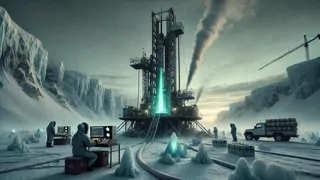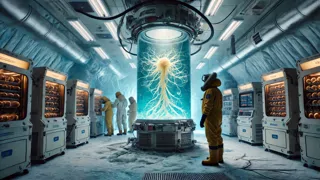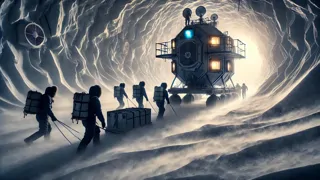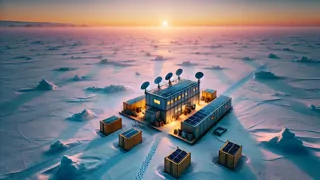Introduction
In the heart of winter, a battered C-130 Hercules thunders across the endless Antarctic expanse, its engines straining against fierce katabatic winds that drag frigid air downhill from the polar plateau. Beneath the cabin’s reinforced floor, crates of geophysical sensors jostle alongside emergency gear, while six veteran scientists and engineers brace in flight-suits for arrival at Camp Helios, the remote U.S. research station carved into an ice shelf. For years, this team has monitored climate shifts and mapped minute variations in glacier movement, but today they carry new orders: investigate a seismic anomaly detected fifty kilometers inland. As the aircraft’s landing skis scrape the snow, a sudden gale whips across the runway, hurling clouds of powdery frost into the twilight sky. Inside the hangar, floodlights sputter against the whiteout, and breath hangs like smoky lanterns in the frigid air. Miles from any other lifeline, the station hums with diesel generators fighting subzero temperatures, and the night sky crackles with auroras that dance like spectral ribbons across the firmament. Dr. Elena Novak checks satellite feeds for atmospheric data, her partner, glaciologist Dr. Marcus Lee, unfurls a circuit of seismic cables, each step threatening to sink into an illuminated thaw zone. Every meter feels surreal: the ice beneath might be thicker than cathedral stone, yet beneath the surface lies something that pulses—something older than human memory, awaiting discovery. They step into the hush of polar night with equipment humming and hearts pounding, unaware that their discoveries will rewrite science, confront every preconception, and draw away a curtain on a presence entombed beneath centuries of ice. The mission meant to chart climate history will become the most profound journey any of them have ever undertaken: a voyage into the unknown heart of Antarctica—and possibly, the universe itself.
Echoes Beneath the Ice
At first light, the team gathered around the echoing hum of the drilling rig, its steel columns rising above the snow like mechanical sentinels surveying a monochrome landscape. They’d spent the previous days calibrating instruments and surveying shallow boreholes, but these readings defied everything they’d seen. Sensor arrays moaned under shifting ice, relaying pulses of low-frequency vibrations that seemed choreographed rather than random. Dr. Lee adjusted the rig’s cold-spray coolant as the tip bored through two meters of permafrost, each rotation kicking up a plume of crystalline frost. “Vibration profile is off the charts,” he murmured into his headset, voice muffled beneath insulated layers. Nearby, systems engineer Priya Singh monitored real-time spectrographic scans, her breath visible on the display screen as she jotted notes in the digital log. The world was silent around them, save for the roar of the engines, the hiss of pneumatic valves, and the crackle of radios trying to maintain contact with the main camp.

Suddenly, the augmented reality overlay on Elena Novak’s goggles flickered, revealing a pale green luminescence deep within the borehole. She stared at the screen, heart racing. The glow pulsed in time with the seismic tremors, as if alive. “We’ve never seen that in any glacial formation,” she reported. The rig slowed to a grinding halt, sensors switching to diagnostic mode. A hush settled over the crew, their faces illuminated by console lights. Even the wind seemed to pause, catching broken shards of ice on the air.
Priya flicked through the thermal profiles, noting concentric arcs of heat that contradicted the expected uniform cold. The map on her tablet showed a cavernous void forming nearly twenty meters below the surface—no simple crevasse or meltwater pocket. It was a structured space, almost symmetrical, etched into the glacier like the walls of an ancient cathedral sculpted by unknown hands. A panel of the rig’s decibel meter surged, as if something deep inside responded to the intrusion. Marcus swallowed, wiping a bead of sweat—an anomaly in fifty-below conditions—from his brow. “We’ve opened a door,” he said, tone half awe and half dread. Elena keyed her comm link. “Camp command, we’re encountering unexpected subsurface anomalies. Requesting permission to proceed with caution.” A crackle of static returned a distant approval tinged with concern. Beyond the rig’s lights, the ice stretched into a void of darkness. They were alone, yet they felt watched.
The Alien Awakens
Deep in the lab’s sterile coolness, the team prepared to extract a biological sample from the ice-cored specimen. A mobile cryo-unit sat between benches, humming with refrigeration coils. The cylindrical chunk of ice, ten centimeters across, displayed embedded nodes that glowed faintly in shifting hues. Dr. Novak donned a reinforced microglove and placed the sample in the thaw chamber, where pulses of regulated heat began to liquefy outer layers. Sensors recorded microstructural changes and gas emissions. Tiny bubbles collapsed and expanded, as if breathing, releasing molecules that danced across the chamber’s interior. Priya leaned over a petri dish, scooping a droplet into a phase-contrast microscope. Under magnification, she glimpsed an organism that resembled a cross between jellyfish tentacles and crystal lattices—a translucent entity with dendritic filaments and softly glowing nodes at each branch. The sight was mesmerizing yet unsettling. A chime indicated five minutes until full thaw. Marcus shut down nonessential systems to preserve power for analysis. Elena watched waveform monitors plot the creature’s responses, little spikes of bioelectric activity each time the environment shifted by a fraction of a degree.

As fracturing ice gave way, the creature began to move. Its tendrils unfurled in a slow, graceful arc, brushing against the chamber walls like curious explorers. Blue-white light pulsed along its body in patterns that seemed deliberate, almost communicative. Researchers exchanged astonished looks as Priya reached for a pH probe to determine acidity changes in the fluid. Every metric defied expectation—there was no rapid decay or toxic byproducts, only a gentle reorganization of matter. Elena dialed back the heat and introduced an isotonic buffer to gauge tolerance. To their amazement, it adjusted its color temperature, shifting from icy azure to warm gold. That reactive flexibility prompted a flurry of activity; they scrambled to bind data to AI algorithms that could simulate its metabolic signature. Outside, the wind rattled lab panels, but inside, time slowed. An unfamiliar excitement permeated the room—an echo of hope and trepidation that this first contact would rewrite biology textbooks.
Communication links to Camp command remained open but tenuous. They feared losing signal precisely when the specimen showed dramatic signs of viability. Elena keyed a short message: “Discovery is viable. Organism responds to stimuli. Prioritizing sustained containment.” She watched lines of code scrolling across her HUD, each representing an encrypted data packet. Meanwhile, Priya prepared microinjection needles loaded with nutrient broth derived from algal cultures. If the creature fed on organic compounds, these test injections would reveal its metabolic pathways. With cautious precision, Elena guided one needle to the organism’s distal branch and released a minute droplet. Instantly, the nodes along that filigree brightened, sending ripples through the fluid medium. The response was undeniable: this entity was alive, sentient, and interactive. A hush followed, broken only by the hum of machinery and the frantic scribbles on lab notebooks documenting the first sample to bridge worlds.
Race to the Rescue
A sudden shift in barometric pressure signaled impending disaster. Through the battered windows of Camp Helios, the researchers watched wind speeds escalate into a nearly horizontal tempest, whipping snow into opaque curtains. Power failures cascaded across the base, extinguishing interior lights and severing primary communications. Emergency sirens blared as diesel fumes leaked from fuel tanks tipped by avalanche tremors. The team huddled in the central hub, illuminated only by battery-operated lamps and the faint glow of their tracking devices. Elena studied the map to the subglacial cavern where they’d stored the alien lifeform, now secured in a reinforced containment pod. Outside, the howling gale threatened to collapse makeshift walkways and sever their last lifeline to support crews waiting halfway across the frozen continent.

Before departure, Elena inhaled the frigid air one last time, tasting the subtle hint of ozone that only an ice storm could conjure. They strapped harnesses around the pod, anchoring it to a sled with reinforced paracord. Priya’s graphene-lined gloves barely dulled the sting of frostbite as she secured heating coils to the casing. A gust nearly pulled Marcus off his feet as he adjusted the sled’s runners for better traction. The wind tore away the tip of the communication antenna, cutting off live telemetry. No safety net remained. Yet, united by purpose, they stepped into the blizzard, carrying the fragile guest through the storm’s wrath toward a perilous rescue.
Navigating the half-buried passage required unwavering focus. Dripping icicles overhead cracked as they edged through collapsed tunnels, following the creature’s hum. When they reached the entrance, they found the cavern partially collapsed—ice columns shearing from the roof, showering shards that glittered like frozen diamonds. Floodlights they’d installed earlier cast weak beams through the swirling snow, illuminating a surreal vista. The air was thin; each breath a fight against cold starvation. Marcus and Priya worked in tandem to mount the pod on a construction-grade crane sled, reinforcing its support frame with quick-melt adhesives and emergency brackets. Elena scanned the chamber, noticing fracture lines that warned of imminent collapse.
Just then, a low rumble shook loose a wall of ice blocks. Massive fragments thundered down the cavern walls. Priya dove toward the pod, bracing it with her weight. Marcus triggered a thermal cutter, severing an overhanging slab before it crushed them. Sparks flew, mingling with swirling snow in the cave’s headlamp glow. Then, as if satisfied, gravity paused its assault. The creature’s bioluminescence flared brightly in the pod, illuminating symbols carved into the ice—runes matching those from the discovery site. In that stilled moment, they felt the ancient architecture guiding them, urging them to carry the being back to the world above.
In the outer tunnel, the storm had eased to a fierce gale. Each researcher was numb, save for an inner flame fueled by triumph and solidarity. They hauled the sled through winding corridors, passing markers half-buried under new drifts. The creature’s glow pulsed in time with their heartbeat, a calming rhythm that steadied their resolve. When they finally emerged inside Camp Helios, they were greeted by emergency lights flickering back to life, as backup generators sputtered into action. The base’s hull groaned, but it held.
Back in the lab, temporary power restored enough to run essential systems. The pod occupied center stage as monitors blinked with stable biometric readouts. Elena exhaled in relief. “We did it,” she whispered. No one needed to add anything. Outside, the wintry dawn bled through frost-lined windows, and for the first time, the station’s alarms sounded not of danger, but of hope. They had risked everything to protect a life that defied all prior knowledge. Antarctica had revealed its final, astonishing secret, and the world would never be the same.
Conclusion
As dawn broke over the battered dunes of Camp Helios, the team gathered around the containment pod to witness the alien lifeform’s subtle, harmonious pulses. The storm had passed, leaving a crystalline landscape of snowfields and softened wreckage. With the creature secured, Elena transmitted their findings across every scientific channel—genetic maps, bioluminescent recordings, and acoustic sequences that defied terrestrial biology. Worldwide, scholars and policymakers would debate whether this entity was a sample or a living conscience deserving its own classification. For the researchers who braved frostbite, avalanches, and broken protocols, the line between explorer and guardian had vanished. Antarctica had revealed its most profound secret, and humanity stood at the threshold of an encounter with extraterrestrial life. They packed provisions for extended missions, ready to return to the subglacial sanctum at first safe opening. Above all, they carried back a message: in isolation and desolation, connection can bloom across worlds. In the hush of Antarctic morning, they stood together, keepers of a spark from beyond, determined to shepherd it with integrity and wonder.

















